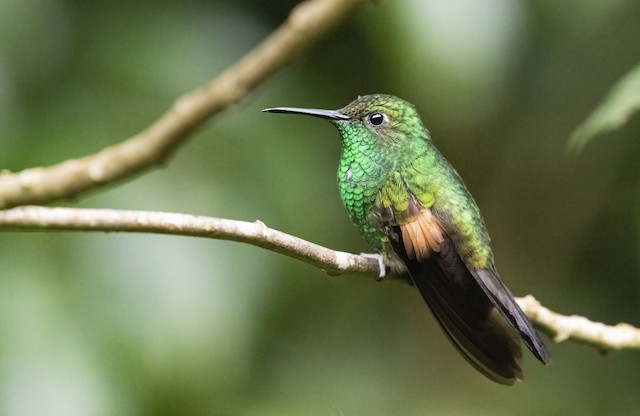The stripe-tailed hummingbird (Eupherusa eximia) is named for the white edges of its distinctive black outer tail feathers. This species is a medium-sized hummingbird with a fine, to some extent, downcurved bill. It has a predominantly green plumage with a reddish wing patch with metallic green underparts (the underwing is mostly rufous-cinnamon). However, in the female, gray-white underparts. Therefore, both sexes, have a straight black bill. Aside from the nominate, there are two subspecies, the more olive-green “subsp. nelson” and the whiter-tailed “subsp. egregia”.
Males of the species are particularly territorial and aggressive, usually defending clusters of epiphyte flowers in the canopy. Females are more likely to trapline and visit lower strata in the forest. The nest is built quite low down in thick cover and is sometimes decorated with bright red lichens. The female normally lays 2 white eggs (about the size of coffee beans) in a tiny cup nest lined with plant fibers. The incubation period is 15 to 20 days. The chicks leave the nest in 25 to 28 days.

Post-breeding, there is marked dispersal to lower altitudes, particularly in Costa Rica and Panama. The population trend is not known, but subsp nelson, the most northerly subspecies, is likely to be under particular pressure from deforestation. This eye-catching hummingbird is endemic to subtropical moist forest foothills and highlands and next to clearings of Middle America, from the Gulf slope of southeastern Mexico to Panama.
Food: Stripe-tailed hummingbirds use their long, extendible, straw-like tongues to feed on the nectar of flowering trees, spiders, insects, shrubs, herbs, and epiphytes.
Distribution: Subsp. eximia occurs from east Mexico south to central Nicaragua; subsp. nelsoni occurs in east and southeast Mexico; subsp. Egregia occurs in Costa Rica and west Panama
Habitat: The preferred habitat is humid upland forest and forest borders, secondary growth; 3,300–8,200 Ft. (1,000–2,500 m)
Size: The normal length is 31⁄2–41⁄8 in (9–10.5 cm). Weight: 4–4.3 g
Status – Least Concern
More Read – 30 Most Beautiful Finches in Asia
